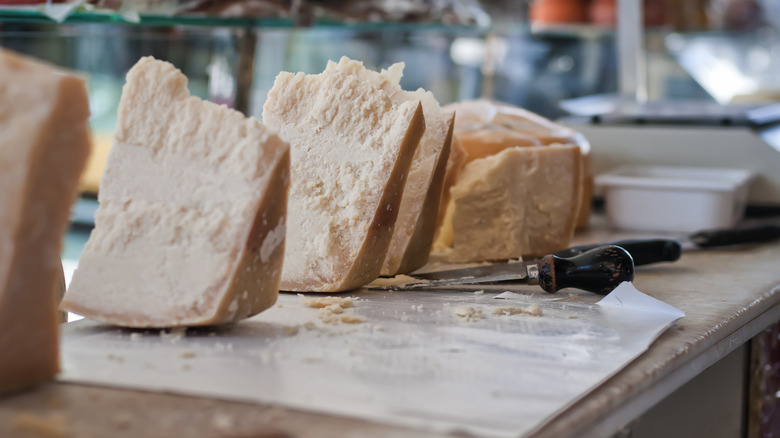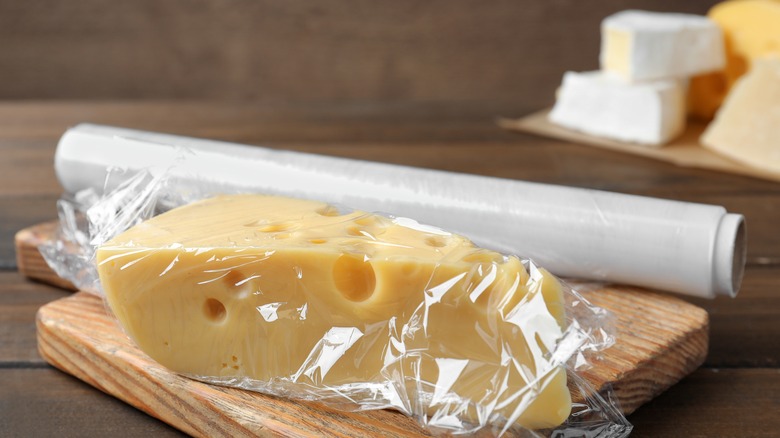How To Store Hard, Soft, Fresh, And Blue Cheese, According To An Expert
Our precious fromage can be fickle, which makes storing it a tricky undertaking. Some cheeses are very sensitive to changes in temperature and humidity while others are surprisingly hardy. While there's the general rule that a fresh, moist cheese will need to be used up sooner than a dry, aged one, other factors come into play. Specifically, how long it lasts also depends on where you store your cheese, whether that's the freezer, fridge, or even out in the open. Once you figure out the best way to store each type of cheese, you are much better positioned to always have your favorite types on hand. Better still, you're much less likely to face the heart-wrenching prospect of throwing away the good stuff.
Cheese can be broadly divided into soft, hard, fresh, and blue. The last refers to any type of cheese that is made with the edible mold Penicillium. We got an exclusive with Dominick DiBartolomeo, Owner and President of The Cheese Store of Beverly Hills and Domenico's Foods, on the best ways to store each type. And if it makes you want to stock up on your favorites right away, you can follow all the cheesy happenings on the store's Instagram page, @thecheesestoreofbeverlyhills.
Hard cheeses can be kept outside in a cool, dry climate for several hours
Firm cheeses have a better shelf life for a few reasons. For one, they have lower levels of moisture than soft cheeses. They also tend to have a higher salt content, making them more naturally preserved. This is one of the reasons why aged cheddar (which is firmer) will taste saltier than creamy young cheddar. The lower moisture and higher salt content make it more difficult for unwanted bacteria or mold to grow on firm cheeses, allowing you to leave them out of the fridge for longer.
"For the firmer cheeses, depending on the season and where you live — cool, dry climates specifically — you can leave a hard, dry cheese like Parmigiano Reggiano out on the counter," explains DiBartolomeo. Of course, this is if you plan on finishing it within the next 24 hours; to make your cheese last for a few days or longer, it's best to refrigerate it, no matter which type it is.
That said, the nice part about being able to leave certain cheeses out for longer is that they then have the perfect eating consistency, which is crucial for enjoying them on a cheese charcuterie board. In general, the cheese expert recommends using discretion — if a cheese looks like it's losing its ideal consistency, it's best to not leave it outside for any longer.
Store blue cheese and fresh cheese seperately
Since being exposed to air saps moisture and aroma, cheese should always be stored covered, irrespective of whether it is refrigerated or not. DiBartolomeo says that cheeses of most textures can be stored together. However, it is their pungency that one needs watch out for. Blue cheese and other stinky cheeses need to be stored separately since their odiferous qualities can make their way into other cheeses. Soft and fresh cheeses are particularly susceptible to absorbing smells from blue cheese or other pungent foods in the fridge.
One major cheese-storing mistake is not wrapping your cheese in clingfilm or, at least, some parchment or butcher paper before placing it in the fridge. While it's not possible with high-moisture cheeses like mozzarella and ricotta which should be stored in airtight containers, other soft and semi-hard cheese blocks should be wrapped to ensure their exposure to air is minimized.
Once individually wrapped, you can store them all together in an airtight box for added protection. And should the worst happen, there are also different ways to deal with soft and hard cheeses. While mold on a hard cheese like parmesan can just be carved off, leaving the rest of the block usable, soft cheese will generally need to be thrown away if you notice any signs of spoilage or fungal growth.


